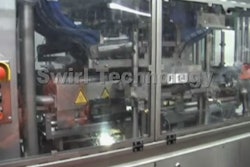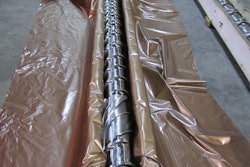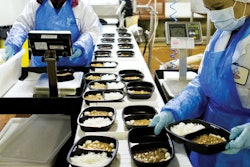American Nutrition, Inc. of Ogden, UT, has been in the business of providing fresh, nutritionally balanced pet-food products since 1977. Operating five manufacturing facilities across the country, the company produces more than 300,000 tons annually of pet food and snacks, including dry, baked, and wet foods.
To protect its products and keep them looking good on the retail shelf, in 2006 American Nutrition switched from multiwall paper bags for its larger-size dog and cat food products to woven-mesh SuperTube™ bags from Coating Excellence Intl. (CEI, www.coating-excellence.com). CEI was one of the first companies to begin producing the woven polypropylene bags in the U.S.
Relates American Nutrition purchasing director Jim Stoltz, “We made the change due to consumer demand, improved packaging strength, and better pricing.” The SuperTube is now used for the company’s Atta Boy dog food and Atta Cat cat food in 16-, 34-, 37.5-, and 50-lb bags.
Domestic supplier emerges
Until recently, woven-mesh film bags for pet food and other non-human food products were available primarily from China (see News item on p. 10). Two years ago, flexible packaging converter CEI, Wrightstown, WI, completed a 120,000-sq-ft expansion to accommodate new equipment for the production of its SuperTube bag for use by U.S. pet-food manufacturers.
“Paper bags were a problem for our customers because some would break open during distribution or after they arrived at retail stores,” says CEI Bag Division general manager Lynda Swenson. “Additionally, the quality and logistics of printing mesh bags offshore to save money created many production challenges for these customers.
“We were approached by customers to solve the problem by developing a higher-quality package that could be manufactured in the U.S. This is really our specialty—to innovate new ideas in packaging and engage our equipment suppliers to create one-of-a-kind machines to do the job.”
The expansion, which brought CEI’s facility to a total of 600,000 sq ft, included the addition of an eight-color Windmöeller & Höelscher (www.whcorp.com) Astraflex® direct-drive, central-impression flexo press; an extrusion laminator from a proprietary supplier; and seven bag-making machines, also proprietary.
During a visit by Packaging World, CEI president Michael Nowak explained that each piece of equipment was chosen for its proficiency in producing the SuperTube bag. “W&H provides outstanding printing utilizing water-based inks on film,” he said. “The extruder has unique capabilities to laminate to a woven tube in one pass, and the bag lines are designed to run woven very efficiently.”
The bag used by American Nutrition is constructed of a 70-ga reverse-printed biaxially oriented PP laminated via a PP extrudate to a 10x10- (warp x weft), 850-denier woven PP mesh tube. Film, extrudate, and mesh are supplied by a number of vendors; the water-based ink used to reverse-print the film is supplied by Sun Chemical (www.sunchemical.com).
CEI can produce bags that range in size from 12 to 20 in. wide and that vary in length from 20 to 46 in. Most bags it manufactures are 20- to 60-lb capacities.
Tube lamination is challenging
During manufacturing, BOPP film is flexo-printed in up to 10 colors (eight on the first pass; two on the second) on the Astraflex press. Water-based inks are used to ensure that the quality, taste, and safety of the bag’s contents are not compromised.
After printing, rollstock is laminated first to the front and then to the back of the woven-mesh tube. Relates Louann S. Mueller, CEI’s vice president of manufacturing, “The challenge to creating the bag is being able to laminate front-to-back in-register in tube format”—a proprietary process that she says gives CEI its marketplace advantage and gives the bag its strength.
Agrees Nowak, “In addition to being strong due to utilizing woven, because the bag is made from a tube, it has only half the seams found in a normal bag, which reduces potential failure areas.”
After being laminated on the extruder, the tube is then gusseted and cut to size, after which one side of the bag is sealed using proprietary bag-making equipment. Once filled at the customer’s site, the bag can be sewn, glued, or taped shut, and can include an easy-open feature. American Nutrition’s bags are sewn, notes Stoltz.
Bag boasts advantages
According to CEI, there are a number of reasons why its customers prefer the woven-mesh bag versus a traditional, multiwall paper bag. Among them is its improved durability. “Once traditional paper bags are ripped even the smallest bit, the integrity of the bag is compromised,” says Nowak. “When numerous pounds of pressure are applied to a small tear in the paper, product quickly spills out and is wasted. This does not happen with the SuperTube bag. If the bag is somehow punctured, the small, resulting tear does not expand, and no additional product is lost.”
The mesh bag also eliminates flex-cracking, which occurs when the outer, clay-coated layer on traditional paper bags is folded, leaving white lines, or cracks, that give the package a worn appearance.
The SuperTube format is also said to allow for maximum branding opportunity, as high-quality graphics are bonded between the bag’s layers, for protection and high gloss, making them vibrant and eye-catching on-shelf.
The bag provides several sustainability benefits, as well. According to CEI, the film bag weighs 50% less than multiwall paper bags, which means less packaging is sent to landfills, transportation costs are reduced, and less storage is required for the bags. Constructed of 100% PP, the bag is also recyclable.
In addition, Nowak says that “CEI’s woven bag uses less than 50% of the energy required to make a traditional, multiwall bag and generates 50% less air and water pollutants in the production process.”
American Nutrition supports CEI’s claims, noting that the SuperTube bags used for their pet-food products cost slightly less than paper for large-quantity orders over 50,000 bags, use less material, are recyclable, and provide enhanced durability over paper bags.
Industry trade groups have also lauded CEI for the aesthetics and functionality of its SuperTube applications. In 2007, the Printing Industries of America/Graphic Arts Technical Foundation (PIA/GATF, www.gain.net) awarded CEI with a Premier Print Award for its SuperTube Kaytee Songbird Blend bag. This year, the Flexible Packaging Assoc. (FPA, www.flexpack.org) presented the company with a Silver Award for Packaging Excellence in its 2008 Flexible Packaging Achievement Awards. CEI’s bags have also been named Best of Show for the past two years in the Flexographic Technical Assoc.’s (www.flexography.com) Excellence in Flexography awards competition.
























